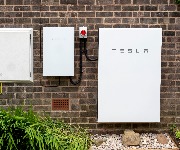The ten worst cities for broadband

Find out which cities have come out bottom (and top) for mobile broadband speed...
Mobile broadband – which lets you connect to the internet via the mobile phone network – has been growing in popularity over the past few years. And it’s no wonder, given the great thing about it is that it allows you to connect to the internet wherever you have a mobile signal, meaning you can get online on the move!
But just as the speed of fixed-line home broadband can be affected by where you live, so can the speed of mobile broadband.
In fact, recent research from Top10.com has revealed which UK towns and cities have the worst 3G mobile broadband speeds. The research analysed thousands of 3G speed tests carried out by smartphone users, via Top10's 3G mobile broadband speed test tool. Here are the results:
The ten worst UK towns and cities for mobile broadband
|
Town/City |
Download speed (Mbps) |
|
Milton Keynes |
1.73 |
|
Leicester |
2.01 |
|
Huddersfield |
2.17 |
|
Cardiff |
2.18 |
|
Liverpool |
2.21 |
|
Blackburn |
2.23 |
|
Stevenage |
2.23 |
|
Hull |
2.35 |
|
Stafford |
2.37 |
|
Birmingham |
2.43 |
Source: Top10.com
So if you live in Milton Keynes and regularly use mobile broadband, you probably won’t be pleased to know that you have the slowest 3G mobile broadband speeds. In fact, the 1.73 megabits per second is around 45% slower than the average speed in Britain’s 3G hotspot towns and cities.
Related how-to guide

Lower your household bills
How to cut your insurance, phone, broadband, water and TV bills, and save thousands of pounds a year!
See the guideAt this speed, it would take up to ten seconds to load a webpage on a smartphone, an hour to start watching a streamed movie, and over two minutes to download a popular app.
Leicester and Huddersfield also suffer from 3G mobile broadband speeds slower than the national average of 2.62Mbps. Indeed, it seems that half of the ten slowest towns and cities for 3G mobile broadband speeds are in the north of England.
So where do you need to live to enjoy the fastest speeds?
The ten best UK towns and cities for mobile broadband
|
Town/City |
Download speed (Mbps) |
|
Peterborough |
3.86 |
|
Carlisle |
3.50 |
|
Eastbourne |
3.47 |
|
Stoke |
3.35 |
|
York |
3.26 |
|
Dundee |
3.24 |
|
Brighton |
3.21 |
|
Derby |
3.12 |
|
Reading |
3.09 |
Source: Top10.com
So if you live in Peterborough, you’re lucky enough to have access to the UK’s fastest 3G mobile broadband speeds!
Speed up your mobile broadband
Fortunately, no matter where you live, if you want to speed up your mobile broadband, there are a few things you can do yourself. Take a look at these top tips*.
1. Check your coverage
Before you sign up to any mobile broadband deal, it’s well worth checking the coverage in your area.
Note that mobile broadband coverage isn't the same as mobile phone coverage. So even if you get good mobile phone reception in your house, it doesn’t necessarily mean you’ll get a strong mobile broadband signal.
Each mobile provider allows you to check mobile broadband availability for your postcode so that you’ll be able to see what kind of speeds you’re likely to receive at home or on your commute to work – you can see a list of coverage and speeds for your postcode here. You can also test your 3G mobile broadband speed with this iPhone app.
2. Get an antenna extension
Many mobile broadband dongles allow you to attach an antenna extension to improve your signal. That said, this won’t make any difference if you have no mobile broadband signal at all.
There are a range of antennas to choose from. For example, you can purchase clip-on, omni-directional models that attach to your USB modem stick or laptop for a better signal from all directions, or high-gain directional antennas that send your 3G signal in one direction, reducing wasted signal strength.
If you have never considered mobile broadband before, here are five reasons why you should
Before you purchase one, however, check with your manufacturer that the antenna you want is compatible with your mobile broadband USB modem stick.
Alternatively, if you’re at home, you could place your 3G dongle in a saucepan! The metal pot acts as an antenna and will concentrate the signal in the centre, improving reception for a dongle placed in the area.
3. Use a USB extension lead
No doubt you’ve already noticed that your mobile broadband signal improves near a window or when you're outside.
However, going outside every time you’re trying to get online isn’t ideal. So instead, you could try plugging your dongle into any standard USB extension lead to extend its range. This means you can place your dongle near a window to get a better signal, while you sit elsewhere!
4. Avoid using 3G on fast moving transport
This is because it will interrupt the signal and give an erratic experience. 3G becomes near-unusable at speeds over 90-100mph.
5. Get a better device
The problem may stem from your device and not the speed of the network. High end 3G devices (such as the iPad 2 versus the original) offer a much faster experience and processing power makes a big difference. So consider upgrading to a fast device if your 3G isn't performing as you would like it to.
6. Ditch your mobile broadband router
If you have a poor mobile broadband connection, using a router to share what little you have will simply make it worse. So ditch your router and plug your dongle in directly.
7. Peer-to-peer programs
Make sure no peer-to-peer programs are running in the background, or things such as Skype or podcast downloads, if web pages are taking a long time to load. These can all slow down your laptop.
8. Peak times
The speed of your connection will also be reduced if a lot of people are using the mobile network at the same time. When you connect using mobile broadband, you’re using a shared data service – so as more people go online and start downloading, the speed each user receives will fall.
So try to avoid using mobile broadband during peak times (usually between 6pm and 11pm) if you can.
9. Cancel your contract
If you sign up to a provider and then find that the speed you’re receiving is slower than a snail walking down your garden path, you can return your dongle and cancel your contract within a certain number of days. This varies from 14 days to one month, depending on who your provider is – check the terms and conditions of your contract for more details.
*Thanks to Broadbandchoices.co.uk and Top10.com for some of these tips.
More: Save a bundle of cash by bundling | Switch your broadband in five easy steps
Most Recent
Comments
Be the first to comment
Do you want to comment on this article? You need to be signed in for this feature








